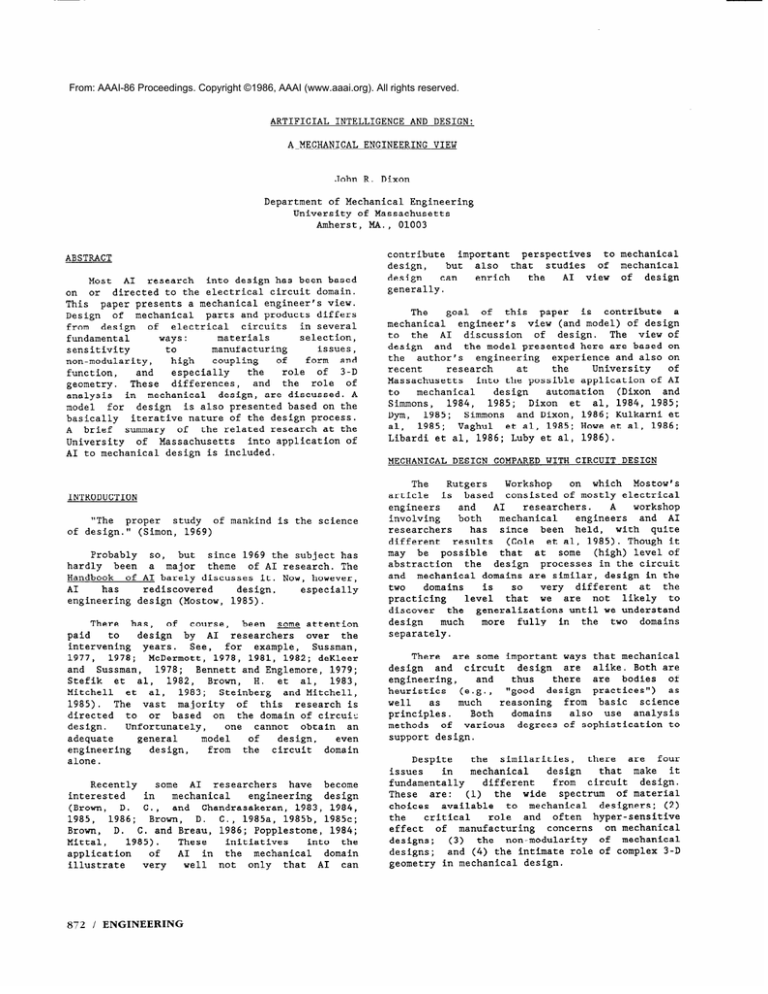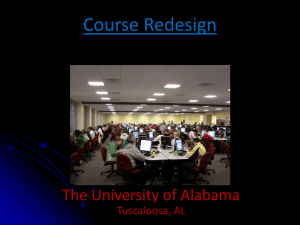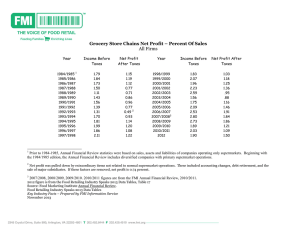
From: AAAI-86 Proceedings. Copyright ©1986, AAAI (www.aaai.org). All rights reserved.
ARTIFICIAL
INTELLIGENCE
A MECHANICAL
AND DESIGN:
ENGINEERING
VIEW
John R. Dixon
Department
of Mechanical
Engineering
University
of Massachusetts
Amherst, MA., 01003
ABSTRACT
Most
AI
research
into design has been based
on or
directed to the electrical
circuit domain.
This
paper presents a mechanical
engineer's view.
parts and products differs
Design
of mechanical
in several
from
design
of
electrical
circuits
fundamental
ways:
materials
selection,
sensitivity
to
manufacturing
issues,
coupling
of
non-modularity,
high
form
and
of
3-D
function,
and
especially
the
role
geometry.
These
differences,
and
the
role
of
design, are discussed. A
analysis
in mechanical
for
design
is also presented based on the
model
basically
iterative nature of the design process.
A brief
summary
of
the related research at the
of Massachusetts
into application
of
University
AI to mechanical
design is included.
contribute
important
perspectives
to mechanical
design,
but
also
that
studies
of mechanical
design
can
enrich
AI view
of
design
the
generally.
goal
of
this
paper
is contribute
a
The
mechanical
engineer's
view (and model) of design
to the
AI
discussion
of
design.
The
view of
design
and
the model presented here are based on
the
author's
engineering
experience
and also on
recent
research
at
the
University
of
Massachusetts
into the possible application
of AI
to
mechanical
design
automation
(Dixon
and
Simmons,
1984,
1985;
Dixon
et
al, 1984, 1985;
Simmons
and Dixon, 1986; Kulkarni et
Dym , 1985;
1985;
Vaghul
et al, 1985; Howe et al, 1986;
al,
Libardi et al, 1986; Luby et al, 1986).
MECHANICAL
INTRODUCTION
"The
proper
study
of mankind
of design." (Simon, 1969)
is the science
Probably
so,
but
since 1969 the subject has
hardly
been
a major
theme
of AI research. The
Handbook
of AI barely discusses
it. Now, however,
AI
has
rediscovered
design,
especially
engineering
design (Mostow, 1985).
There
has,
of
course,
been
some attention
paid
to
design
by AI
researchers
over
the
intervening
years.
See,
for
example,
Sussman,
1977,
1978;
McDermott,
1978, 1981, 1982; deKleer
and
Sussman,
1978;
Bennett and Englemore,
1979;
Stefik
et al,
1982,
Brown,
H.
et al,
1983,
Mitchell
et
al,
1983 ; Steinberg
and Mitchell,
1985).
The
vast
majority
of
this
research is
directed
to
or based
on
the domain of circuit
design.
Unfortunately,
one
cannot
obtain
an
adequate
general
model
of
design,
even
engineering
design,
from
the
circuit
domain
alone.
Recently
some
AI
researchers
have
become
interested
in
mechanical
engineering
design
(Brown,
D.
C.,
and
Chandrasakeran,
1983, 1984,
1985,
1986;
Brown,
D.
C., 1985a, 1985b, 1985c;
Brown,
D.
C. and Breau, 1986; Popplestone,
1984;
Mittal,
1985).
These
initiatives
into
the
application
of
AI
in the
mechanical
domain
illustrate
very
well
not
only
that
AI
can
872
/ ENGINEERING
DESIGN
COMPARED
WITH
CIRCUIT
DESIGN
The
Rutgers
Workshop
on which
Mostow's
article
is based
consisted of mostly electrical
engineers
and
AI
researchers.
A
workshop
involving
both
mechanical
engineers
and
AI
researchers
has
since
been
held,
with
quite
different
results
et al, 1985). Though it
(Cole
may
be
possible
that
at
some
(high) level of
abstraction
the
design
processes
in the circuit
and
mechanical
domains are similar, design in the
domains
is
so
two
very
different
at
the
practicing
level
not
likely
to
that
we
are
discover
the
generalizations
until we understand
more
fully
in the
two
domains
design
much
separately.
are some important ways that mechanical
There
design
and
circuit
design
are
alike. Both are
are
bodies
of
engineering,
and
thus
there
heuristics
(e.g.,
"good
design
practices")
as
reasoning
from
basic
science
well
as
much
principles.
Both
domains
also
use
analysis
degrees of sophistication
to
methods
of various
support design.
Despite
the
similarities,
there
are
four
issues
in
mechanical
design
that
make
it
fundamentally
different
from
circuit
design.
(1)
the
wide
spectrum
of material
These
are:
available
to mechanical
designers;
(2)
choices
the
critical
role
and
often
hyper-sensitive
concerns
on mechanical
effect
of
manufacturing
(3)
the
non-modularity
of mechanical
designs;
and (4) the intimate role of complex 3-D
designs;
geometry in mechanical
design.
Perhaps
the
most
significant
of
these
between mechanical
design and circuit
differences
design
is
in the
role
of
3-D
geometry.
In
material
specification,
a
addition
to
a
mechanical
design
&
a description
of
a 3-D
Is. Though Mostow's paper does not even
geometry.
geometry as an issue in developing better
mention
models
of
the
design
process, it is a critical
design.
Moreover,
central
issue
in mechanical
manufacturing,
and function are highly
geometry,
coupled in mechanical
design (Rinderle, 1986).
the
natural
language
of
Geometry
is
Mechanical
designers "think"
mechanical
design.
There
is no
mathematical
geometry.
in
3-D
between the mental image or concept of
connection
a design
and
its 3-D visual representation
in a
drawing.
Whether
on
paper or on a CAD terminal,
designers
sketch,
erase,
and sketch
mechanical
again.
A mechanical
design is seldom the solution
equations;
it is instead
to a set of constrained
a representation
-- a drawing -- of a 3-D object.
It may
be
noted that three of the points of
-listed
above
materials,
difference
and geometry
-- each constitutes
manufacturing,
of
knowledge.
There
are
also
a
huge
body
interactions
among
these
topics.
important
this is knowledge
that is not naturally
Moreover,
represented
by equations.
shall
materials
be
represented
so that
How
can reason about them? How shall
design
programs
processes
and
machine
tools
be
manufacturing
that
design
programs
can
be
represented
so
that
consider
the
properly
written
designs as well as plan the
manufacturability
of
production
process? And especially,
how shall the
a design
be
represented
so
that
geometry
of
reason about that geometry,
design
programs
can
function
and
it
to
both
relating
are
issues
that
These
manufacturability?
circuit
mechanical
design
from
distinguish
and
which must be studied in addition to
design,
to develop
adequate
common
issues
if we
are
process
the
engineering
design
models
of
generally.
THE ROLE
OF ANALYSIS
IN MECHANICAL
Sometimes
parts
of
a design problem can be
formulated
as optimization
problems, and in these
optimization
methods are
instances,
sub-problem
is a whole, real
Seldom,
however,
useful.
very
expressable
as
a
mechanical
design
problem
optimization
problem. The designer's
mathematical
lot will never be such an easy one.
Hopes
persist that design can somehow be done
directly
by
some
form
of
"analysis",
that is,
The essential
iteration.
I doubt
it.
without
design
nature of design
-- at least mechanical
-to
learn
to
iterative.
Therefore,
is
construct
programs
that
can
design, we need to
learn
first
how
to
guide' iterative
processes
intelligently
so that
acceptable
designs can be
produced efficiently.
MODELLING
THE MECHANICAL
DESIGN
PROCESS
We need
a model
or models
of
the design
to
formulate design problems,
process
in order
represent
design
knowledge,
and to
acquire
and
develop
design inference engines. Most mechanical
that the basic nature of design
accept
engineers
are variations
in
However,
there
is
iterative.
exact nature of how a design problem is to be
the
and
just
what
the
process
is
in
formulated,
detail.
We
view
design
as
a hierarchy
of nested
of
(1) decomposition
and
processes
iterative
and
specification
redecomposition,
(2)
redesign.
and
and
(3) design
respecification,
the decomposition
aspect of this
Figure
1 shows
A
That
is, node
tree.
simple
model
as
a
complex problem to be solved. Nodes
designates
a
D represent
a decomposition
of the
B,
C, and
problem into sub-problems,
and so on.
Decomposition
continues
until
sub-problem
DESIGN
Before
discussing
a model
of
engineering
design
from a mechanical
view, it is necessary
to
in mechanical
the
role
of
analysis
consider
equations
and
mechanical
design,
design.
In
the
design process
analyses
enter
mathematical
only
after
a trial
design
has been developed.
Analyses
are
used
to
simulate
or predict the
performance
of
a prospective
design
for
its
intended use.
It
is
a fundamental
intellectual
error,
therefore,
to
believe
that
analyses,
by
themselves,
can
produce
designs.
Analysis
supports
and
assists
design by providing useful
information
about
how
a proposed
design
will
perform,
but
an
analysis
does
not
produce
a
design
since
there
must
already be a design in
order for an analysis to be performed.
Figure
I.
Decomposition into Sub-Problems.
APPLICATIONS
/ 873
and complexity
is reduced to the point where
size
the
problem can be managed intellectually
without
Usually this is a problem
further
decomposition.
design
small
number
of
relatively
with
a
three to ten or twelve. These
perhaps
variables,
(i.e.,
designs
solved
then
sub-problems
are
developed)
by
a process
we call "redesign". We
this redesign process in some
shall
now
discuss
then return to the decomposition
part
detail
and
of the model.
model of design is
The
redesign
Redesign.
is specified in
in Figure
2. A problem
shown
An initial design
of
problem
parameters.
terms
generates
an
initial
trial
design.
procedure
the
final design. If it is
-(Seldom
is this
initial design procedure
is so
that
is,
if the
acceptable
designs, then
it produces
good
that
interest
further
domain
is
of
no
the
exist
in some
Such
procedures
intellectually.
are not concerned with such well
domains
but
we
trial design is
Next
the
understood
problems.)
determine its
analyzed
to
evaluated;
that
is,
performance
in terms
of performance
expected
include cost, function, and
parameters
that
may
issues. Then a decision is made
manufacturability
design's acceptability.
(Simon
the
trial
as
to
coined
the
word "satisficing"
for this concept.)
If
the
the
task
is
design
is acceptable,
complete.
If not,
the
design is redesigned
and
re-evaluated,
and
so on
iteratively.
Often in
practice,
redesign
ultimately
fails
and
the
process
returns
to
the
initial
step
with the
information
that the problem requirements
need to
be changed, usually relaxed, in some manner.
all
making
and
hard.
the
tradeoffs
is excruciatingly
sub-problems
that
need no
for
In
summary,
further
decomposition
to be managed, design is
It is an important
iterative
redesign.
done
by
intelligent process.
Our work with
Independent"
Redesign.
"Domain
redesign
has
progressed
to
the
point where we
prototype
of a program (called
have
a working
that
designs redesign class problems in
Dominic)
et al, 1986). Dominic has
several
domains
(Howe
successfully
to date in four distinctly
designed
tests
are
in
other
and
different
domains,
progress.
hill-climbing
essentially
a
Dominic
is
this
sense
it
is similar
to
algorithm.
In
It
differs, however, in
otimization
techniques.
is guided by heuristic
First,
it
two
respects.
obtained
from a domain expert.
domain
knowledge
its
input
format is a kind of low level
Second,
design
problem
natural
to
more
language
formal
mathematics
of
than
the
formulation
optimization
methods.
a very strong nor a very
is neither
Dominic
method. It lies in-between
weak
problem
solving
extremes.
It works "generally",
but only on
these
of
design problems. It makes use of
a sub-class
knowledge,
but also possesses
some general
domain
of
how to go about solving problems in
knowledge
It may
be
that
such
strong/weak
class.
its
can
be
a practical
way to apply AI in
methods
design.
A great
deal of mechanical
design is done by
this
iterative
redesign
process.
Despite
its
importance,
however,
it appears to me that many
AI
researchers
tend
to belittle
or at
least
redesign.
There
ignore,
are perhaps two reasons
this.
One
stems
from
an
association
of
for
with
"generate
and
test"
(Lindsay et
redesign
al.,
1980);
the
other
from
an
association
of
"debugging
of
redesign
with
with
process
of
(Sussman, 1977).
almost right" solutions
1
1
GET SPECIFICATIONS
and
test
&
a rather poor process
Generate
for
design
if what
one
means
is to generate
and exhaustively.
But this is not at all
randomly
In redesign,
the
what
is meant
by
redesign.
for
and
the
reasons
analysis
results
used
heuristically
to guide
are
unacceptability
the changes made in the design.
phrase
"debugging
of
almost
right
The
something
rather
solutions"
also
suggests
design
is already
trivial.
After
all,
if the
"almost"
right, the really hard intellectual
work
already
been
done, hasn't it? In mechanical
has
designing
a
design,
usually
not.
When
refrigerator,
one
does not begin with the design
of
a tractor. When designing an automobile
drive
shaft,
one
does not start with an initial design
In all
but
the
most
novel and
of a fender.
unstructured
design situations
(say, starting out
to
design
the first Polaroid camera), getting an
"almost"
right
solution
is relatively
easy,
whereas
getting
rid of all the unacceptabilities
874
/ ENGINEERING
I
REDESIGN
fails
Figure
2.
The Redesign
Model
of Design.
the
specification
changes
what
next
round
of
should
be.
In other words, the sub-problems
can
request
a change
that
will
affect
the
other
sub-problems,
but they cannot impose it. Only the
module
in
a position
to
tradeoff
competing
power to impose or "propagate"
requests
has
the
constraints
on
sub-problems.
This is as it must
be
to
retain
control
of
this
very
complex
process.
Decomposition.
We
return
now
to
the
that
decomposition
process
leads
to
the
solvable
by
redesign.
A tentative
sub-problems
a decomposition
node is shown in
architecture
of
Figure
3. A problem
specification
is received
from
above
in the hierarchy.
If the problem can
be
solved
by
redesign,
this
is done, and the
results
returned
upward.
If not,
an
intial
decomposition
is made. Using this decomposition,
initial
specifications
are
assigned
to
the
sub-problems
created.
(This
assignment
of
specifications
is a key
step;
the sub-problem
specs
are,
in fact
design
variables
at
this
stage.)
These
problems
are
then
passed to the
modules
below,
which are similar in structure to
the
one
being
described.
The
results returned
from
the various sub-problems
are then integrated
and
analyzed
as
a complete
system.
If
the
complete
system
result
is acceptable,
it
is
passed
upward.
If
not,
new
sub-problem
specifications
are
assigned,
and
the
process
repeated.
If the
respecifier
must admit defeat,
then
a new
decomposition
may
be tried. If the
re-decomposer
must
admit
defeat,
the
system
reports
failure
up
the
line, and asks for some
change in the overall problem assignment.
Others
are also working
decompose
problems
for
advanced
is the
excellent
and
Chandrasakeran,
(Brown
GEOMETRY
How
shall
we
represent
design
geometries?
Answering
this
question
is key
to our future
to construct knowledge-based
systems that
ability
can
serve
to integrate CAD, CAM, and engineering
analysis
(CAE). Since so much of our knowledge of
manufacturing
is currently expressed in terms of
geometric
features,
the answer appears to be "In
terms
of
features."
But,
what,
exactly
is a
"feature",
and
how
shall
the
desired features
representations
of designs be obtained?
It
is to be noted that this model does not
allow
for passing of information
or "constraints"
between
sub-problems
in the hierarchy.
Only chaos
can
result
from such communication.
Our model is
autocratic;
information
is passed
only
up
or
down.
What we do include, however,
is a mechanism
for
each
sub-problem
to
pass
up
a
re-specification
request.
This
information
is
then
a part of the information used to determine
We
have been addressing
these questions about
features
in our research.
So far, the definition
of
a feature
is
simply
"any geometric form or
entity
whose
presence
or dimensions
in a domain
are
germain
to
manufacturing
evaluation
or
planning,
or
to
automation
of
functional
analyses".
We
have
experimented
with
several
different
types
of
features
in several domains
COMMUNICATIONS
I
INITIAL
,
DECOMP II
c
INITIAL
*SPECS
fails
INTERFACE
1
I
I
c
l
e
OK
I
I
REDECOMP
on design models that
solution.
The
most
and
useful
work by
1986).
<
ACCEPT?
fails
I
OK
I
COMMUNICATIONS
TO SIMILAR
Figure
3.
INTERFACE
SUBPROBLEM
I
MODULES
A Typical Decomposition Module.
APPLICATIONS
/ 875
molding, and casting), and
(extrusion,
injection
working
prototype
research
have
constructed
"design-with-features"
that
provide
a
programs
(Dixon, 1985; Vaghul,
environment
for
designers
Libardi,
1986; Luby, 1986). These programs
1985;
of the design,
create
a features representations
this
representation
to draw the part in
and
use
extrusion
In
the
solid
form.
wire
frame
or
the features representation
is then used
program,
automatic finite element analysis
to
develop
an
deflections
in a loaded
and
for
stresses
injection molding and casting
the
extrusion.
In
of the geometry is
representation
the
programs,
for
on-line evaluation of the
used
as
a basis
the
in-progress
designs.
manufacturability
of
like
a
bit
function
a
These
programs
looking
and
who
is
expert
manufactururing
the
designer
the
shoulder
of
over
commenting
REFERENCES
while
he or she designs. The programs are simple;
it remains
to be seen whether adding complexity
will create insurmountable
difficulties.
and
Breau,
R,
Brown,
D.
C.
(19861, "Types of
Design Problem-Solving",
in Routine
Constraints
International
Conference
on Application
of
First
AI
to Engineering
Problems, Southampton,
England,
April.
also
been
working on the
Others
have
been
ways (Pratt, 1984;
concept
in various
features
1984). Also, rather
Popplestone,
1978;
Latombe,
than
designing
with
features
as we are doing,
attempting
to extract or infer features
are
some
surfaces
and
lines,
the
points,
from
created
by
existing
CAD systems
representation
(Henderson,
1984).
SUMMARY
AND
CONCLUSION
(1) that
this
paper
are:
themes
of
The
from
different
very
design
is
mechanical
also be studied in
must
and
electrical
design,
general
models
of
the design
order
to obtain
the
differences
involve the
(2)
that
process;
two domains with
involvement
in the
degree
of
processes,
and
selection, manufacturing
materials
(3)
that
good analysis is
especially
geometry;
for
good design, but design is not and
important
cannot
be
done
by
analysis alone; (4) that the
design
process
is iterative;
(5) that design can
inside
redesign
iterative
modelled
as
be
iterative
inside
respecification
iterative
and respecification
but
redesign
decomposition,
the
most important;
(6) that learning how to
are
iterative
processes
is
intellectually
guide
methods can be
strong/weak
(7)
that
important;
developed
for
design
problem
solving; (8) that
learning
how to represent the geometry of designs
issue
for
applying
AI to mechanical
is a key
and
(9) that
most
likely
the
way to
design;
in terms
of
geometry
is
design
represent
features.
If this paper has expanded the reader's model
of
design
by
providing
useful insight into the
the
mechanical
design process, it has
nature
of
served its purpose well.
ACKNOWLEDGEMENT
the
University
of Massachusetts
Research
at
of AI to mechanical
design
application
into
the
in part by grants from
sponsored
automation
is
General Electric.
876
/ ENGINEERING
Bennett,
J.
S.
and
Englemore, , R.
S.
(1979).
for
Consultant
"SACON:
A
knowledge-Based
Sixth IJCAI, Palo Alto.
Structural Analysis",
"Capturing
Mechanical
(1985a)
Brown,
D.
C.,
Proceedings
ASME Computers in
Design
Knowledge",
Engineering
Conference,
Boston, MA., August.
"Failure
(1985b)
Brown,
D.
C.
Design Expert System" CAD Journal,
Design, Vol 17, No 9, November.
D. C. (1985c) "Capturing
Brown,
Computers
Knowledge",
ASME
Conference,
Boston, MA. August.
Handling
Computer
in a
Aided
Mechanical
Design
Engineering
in
and Chandrasakeran,
Brown,
D.
C.
Expert
Systems
Approach
to
Design",
Proceedings
IEEE
Applications,
Gaithersburg,
MD.
B., (1983) "An
for
Mechanical
Trends
and
(1984)
Chandrasakeran,
B.
Brown,
D.
C. and
"Expert
Systems
for a Class Of Mechanical
Design
Working
WG5.2
IFIP
Activity,
Proceedings
on
Knowledge
Engineering
in Computer
Conference
Aided Design, Budapest, Hungary, September.
C. and Chandrasakeran,
Brown,
D.
Design
Problem
Selection
in
Warwick, England, April.
B. (1985) "Plan
AIS85,
Solving"
Chandrasakeran,
B.
and
Brown,
D.
C.
for
a Mechanical
Control
"Knowledge
and
Expert System", IEEE Computer, July.
(1986)
Design
(1983)
and
Foyster,
G.
Tong,
C.,
Brown,
H.,
An Exploratory
Environment
for Circuit
"Palladia:
Design", Computer, Vol 16, No 12, December.
Stall,
H.
W., Parunak, V. (1985)
Cole,
J. H.,
Report
No.
in Machine,
Intellipence
Machine
85-20, Industrial
Technology
Inst., Ann Arbor, MI
"Expert
and Simmons, M. K. (1984)
Dixon,
J. R.
Systems
for
Design: Standard V-Belt Drive Design
Design-Evaluate-Redesign
an
Example
of
the
as
ASME
Computers
in
Proceedings
Architecture",
Engineering
Conference,
Boston, MA. August.
and
Simmons, M. K. (1985) "Expert
Dixon,
J. R.
for
Mechanical
Design:
A
Program
of
Systems
85-DET-78,
Design
Research",
ASME
Paper
No.
Ohio,
Cincinnati,
Engineering
Conference,
September.
Simmons,
M. K., and Cohen, P. R.
Dixon,
J.
R.,
"An
Architecture
for Applying Artificial
(1984)
Intelligence
to
Design", Proceedings
IEEE Design
Automation
Conference,
Albuquerque,
NM, June.
Dixon,
J. R.,
Libardi,
E.
C.,
Luby,
S.
C.,
Vaghul,
M.
V., and Simmons, M. K. (1985) "Expert
Systems
for
Mechanical
Examples
of
Design:
Symbolic
Representations
of
Design Geometries",
in Applications
of
Knowledge-Based
Systems to
Engineering
Analysis and Design, ASME Publication
No. AD-lo, New York.
de
Kleer,
"Propagation
Synthesis",
485.
J.
of
MIT
and
Sussman,
G.
J.
(1978)
Constraints
Applied
to Circuit
Artificial
Intelligence
Memeo
Dym, C. L. (1985) Applications
of Knowledge-Based
Systems
to
Ennineerinp
and
Design, Publication
No.
AD-lo,
American
Society
of Mechanical
Engineers, New York.
Henderson,
M.
R.
"Extraction
of Feature
(1984)
Information
From Three Dimensional
CAD Data", Ph.
D. Thesis, Purdue University,
Lafayette,
Indiana.
Howe,
A.,
Simmons,
M
Independent
Design",
Conference
Intelligence
Southampton,
Dixon,
J.
R.,
Cohen,
P. R.,
and
K.
A Domain
(1986)
"Dominic:
Program
for
Mechanical
Engineering
Proceedings
International
First
Application
of
Artificial
on
to
Engineering
Problems,
England, April.
Kulkarni,
V. M.,
Dixon,
J. R., Simmons, M. K.,
and
Sunderland,
J. E. (1985) "Expert Systems for
Design:
The
Design of Heat Fins as an Example of
Conflicting
Sub-goals
and
the
Use
of
Dependencies",
Proceedings
ASME
Computers
in
Engineering
Conference,
Boston, MA., August.
(1976)
Intelligence
in
Latombe,
J.
"Artificial
Computer-Aided
Design: The TROPIC System" TR 125,
Stanford Research Institute,
February.
Libardi,
E.
C., Dixon, J. R., and Simmons, M. K.
"Designing With Features: Extrusions As AN
(1986)
Design
Paper
No.
86-DE-4
ASME
Example"
Engineering
Conference,
Chicago, March.
Buchanan, B. G., Fiegenbaum,
E. A.,
Lindsay,
R.,
(1980)
DENDRAL,
McGraw-Hill,
New
Lederberg,
J.
York.
Dixon,
J. R., and Simmons, M. K.
Luby,
S.
L.,
Creating
and
"Designing
With
Features:
(1986)
Using
a Features
Data
Base
for
Evaluation
of
Proceedings
ASME
Castings",
Manufacturing
of
Chicago,
in Engineering
Conference,
Computers
July.
(1978)
"Circuit Design as Problem
McDermott,
D.
Artificial
Intelligence
and
Pattern
Solving"
Recognition
in Computer Aided Design, J. Latombe
Publishing
Company,
North-Holland
(Ed),
Amsterdam.
Knowledge and the
"Domain
McDermott,
J.
(1981)
Process",
Eighteenth
Design
Automation
Design
ACM/IEEE,
Nashville,
Tennessee, July.
Conference,
McDermott,
J. (1982)
of
Computer Systems,
19, No 1, September.
"Rl: A Rule-Based
Configurer
Artificial
Intellipence,
Vol
Mittal,
S, Morjaria,
M.,
and Dym, C. L. (1985)
An
Expert System for the Design of Paper
"PRIDE:
in Applications
of Knowledge
Handling
Systems",
Based
Systems to Engineering
Analvsis and Design,
Publication
no.
AD-lo,
American
Society
of
Mechanical
Engineers, New York.
L., Kedar-Cabelli,
Mitchell,
T. M., Steinberg,
Shulman,
J.,
and Weinrich, T.,
S
Kelly,
V.,
"An
Intelligent
Aid for Circuit Redesign"
(1983)
Proceedings
Third NCAI, Washington,
D. C.
Mostow,
J.
(1985)s "Towards Better Models
Design Process" AI Magazine,
Vol 6, No 1.
of the
"The
Application
of
(1984)
Popplestone,
R.
J.
Design
Systems",
Intelligence
to
Artificial
International
Symposium
on
Proceedings
First
Design and Synthesis
(ISDS, Tokyo, Japan.
ffSolid Modelling
and the
Pratt,
M.
J.
(1984)
Design and Manufacture",
IEEE,
Interface I Between
CG and A.
"Function,
Form,
J.
R.
(1986)
Rinderle,
Decomposistion
Fabrication
Relations
and
Strategies
in Design" Proceedings
ASME Computers
in Engineering
Conference,
Chicago, July.
Simmons,
M. K. and Dixon, J. R. (1986) "Reasoning
About
Quantitative
Methods
in
Engineering
Design",
in Coupling
Svmbolic
and
Numerical
Computing
Svsdtems
in Expert
Systems,
J.
S.
Kowalik (Ed), North-Holland,
Amsterdam.
Simon,
H.
A.
The
Sciences
Cambridge, MA.
(1969)
"The Science of Design" in
of
the
Artificial,
MIT
Press,
Stefik,
M., Bobrow, D., Brown, H., Conway, L. and
Tong,
C., (1982) "The Partitionong
of Concerns in
Digital
System
Design",
Proceedings
of
the
Conference
on Advanced
Research
in VLSI, MIT,
Cambridge, MA.
Steinberg,
L.
I. and
Mitchell,
T. M.
(1985).
"Redesign
System:
A Knowledge-Based
Approach to
VLSI
CAD", IEEE Design and Test of Computers, Vol
2, Number 1, February.
Sussman,
G. (1977), "Electrical
for
Artificial
Intelligence
IJCAI.
Design: A Problem
Research",
Fifth
Sussman,
G.
J.,
(1978) "Slices: At the Boundary
Between
Analysis
and
Synthesis"
Artificial
Intelligence
and Pattern Recognition
in Computer
Aided
Design,
J.
Latombe
(Ed),
North-Holland,
Amsterdam.
Vaghul,
M.
V.,
Dixon, J. R., and Simmons, M. K.
(1985)
"Expert
Systems
in a CAD
Environment:
Injection
Molding
as
an
Example",
Proceedings
ASME
Computers
in Engineering
Conference,
Boston,
APPLICATIONS
/ 877





